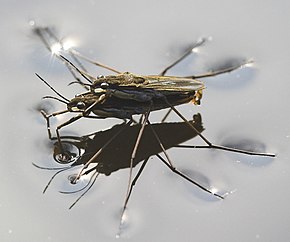
Back Neuston German Neuston Spanish Neuston Estonian سطحآبزیان Persian Neuston French Neusto Galician Neuston Italian ニューストン Japanese Нейстон Kazakh Неустон Macedonian

Neuston, also called pleuston, are organisms that live at the surface of a body of water, such as an ocean, estuary, lake, river, or pond. Neuston can live on top of the water surface or may be attached to the underside of the water surface. They may also exist in the surface microlayer that forms between the top side and the underside. Neuston have been defined as "organisms living at the air/water interface of freshwater, estuarine, and marine habitats or referring to the biota on or directly below the water’s surface layer."[1]
The word neuston comes from the Greek neustos, meaning "swimming" + -on (as in "plankton").[2] This term first appears in the biological literature in 1917.[3] The alternative term pleuston comes from the Greek plein, meaning "to sail or float". The first known use of this word was in 1909, before the first known use of neuston.[4] In the past various authors have attempted distinctions between neuston and pleuston, but these distinctions have not been widely adopted. As of 2021, the two terms are usually used somewhat interchangeably, and neuston is used more often than pleuston.
- ^ Kennish, Michael J., ed. (2016). "Encyclopedia of Estuaries". Encyclopedia of Earth Sciences Series. Dordrecht: Springer Netherlands. doi:10.1007/978-94-017-8801-4. ISBN 978-94-017-8800-7. ISSN 1388-4360. S2CID 129770661.
- ^ Merriam-Webster Dictionary: neuston. Accessed 18 December 2021.
- ^ Cite error: The named reference
Naumann2017was invoked but never defined (see the help page). - ^ Merriam-Webster Dictionary: pleuston. Accessed 18 December 2021.
© MMXXIII Rich X Search. We shall prevail. All rights reserved. Rich X Search